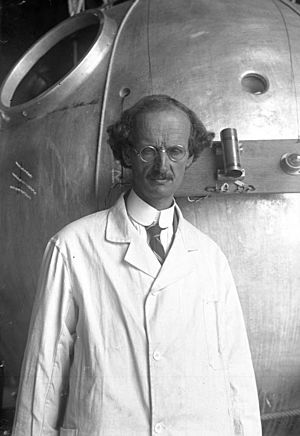Auguste Piccard facts for kids
Quick facts for kids
Auguste Piccard
|
|
|---|---|

Auguste Piccard in 1932
|
|
| Born |
Auguste Antoine Piccard
28 January 1884 |
| Died | 24 March 1962 (aged 78) |
| Nationality | Swiss |
| Known for | Bathyscaphe Magnetocaloric effect |
| Children | Jacques Piccard (son) |
| Relatives |
|
| Alma mater | ETH Zurich |
| Scientific career | |
| Fields | physics, inventor, explorer |
| Institutions | Free University of Brussels (now Université Libre de Bruxelles and Vrije Universiteit Brussel) |
Auguste Antoine Piccard (born January 28, 1884 – died March 24, 1962) was a Swiss scientist, inventor, and explorer. He was famous for his amazing balloon flights. He used these flights to study the Earth's upper atmosphere. Piccard also invented the first bathyscaphe, a special submarine called FNRS-2. He used it to explore the deep parts of the ocean.
Auguste's twin brother, Jean Felix Piccard, was also a well-known scientist and explorer. Many other members of their family, like Jacques Piccard and Bertrand Piccard, also became famous explorers.
Biography
Auguste Piccard and his twin brother, Jean Felix Piccard, were born in Basel, Switzerland. This happened on January 28, 1884.
From a young age, Auguste was very interested in science. He studied at the Swiss Federal Institute of Technology in Zürich. In 1922, he became a professor of physics at the Free University of Brussels in Brussels. His son, Jacques Piccard, was born that same year.
Exploring the Sky
In 1930, Piccard became interested in ballooning. He was curious about the upper parts of the atmosphere. He designed a special round, sealed aluminum cabin, called a gondola. This gondola would let him go very high without needing a special pressure suit. The Belgian Fonds National de la Recherche Scientifique (FNRS) helped him build it.
One big reason for his high-altitude research was to measure cosmic radiation. Scientists believed this radiation could help prove Albert Einstein's theories. Piccard knew Einstein from science conferences.
"A huge yellow balloon soared skyward, a few weeks ago, from Augsberg, Germany. Instead of a basket, it trailed an air-thin black-and-silver aluminum ball. Within [the contraption] Prof. Auguste Piccard, physicist, and Charles Kipfer aimed to explore the air 50,000 feet up. Seventeen hours later, after being given up for dead, they returned safely from an estimated height of more than 52,000 feet, almost ten miles, shattering every aircraft altitude record."
On May 27, 1931, Auguste Piccard and Paul Kipfer took off from Augsburg, Germany. They reached a record height of 15,781 meters (about 9.8 miles). During this flight, they became the first people to enter the stratosphere. They gathered important information about the upper atmosphere. They also measured cosmic rays. Many believe Piccard and Kipfer were the first people to actually see the curve of the Earth.
On August 18, 1932, Piccard and Max Cosyns made another record-breaking flight. They launched from Dübendorf, Switzerland, and went up to 16,201 meters (about 10 miles). Auguste Piccard made a total of 27 balloon flights. His highest record was 23,000 meters (about 14.3 miles).
Exploring the Ocean
In the mid-1930s, Piccard started thinking about something new. He realized that his high-altitude balloon cabin could be changed to go deep into the ocean. By 1937, he had designed the bathyscaphe. This was a small steel cabin built to handle the huge pressure of the deep ocean.
Work on the bathyscaphe began, but it was stopped by World War II. After the war, in 1945, he finished building the special bubble-shaped cabin. This cabin kept normal air pressure inside for a person, even when the water pressure outside was extremely high.
Above the heavy steel cabin, there was a large tank filled with a light liquid. This liquid was gasoline, used for floating, not as fuel. Liquids don't get squashed by pressure, so they keep their ability to float. To make the craft sink, tons of iron weights were attached. These weights could be released to allow the craft to float back up.
This amazing craft was named FNRS-2. It made several unmanned dives in 1948. Later, it was given to the French Navy in 1950. They redesigned it, and in 1954, it safely took a person down to 4,176 meters (about 2.6 miles).
Piccard and his son, Jacques, built a second bathyscaphe. In 1953, they dove together to a record depth of 3,150 meters (about 1.9 miles).
Auguste Piccard passed away on March 24, 1962, from a heart attack. He was 78 years old and died at his home in Lausanne, Switzerland.
Piccard family
- Jules Piccard (professor of chemistry)
- Auguste Piccard (physicist, aeronaut, balloonist, hydronaut)
- Jacques Piccard (hydronaut)
- Bertrand Piccard (aeronaut, balloonist)
- Jacques Piccard (hydronaut)
- Jean Felix Piccard (organic chemist, aeronaut, and balloonist)
- Jeannette Piccard (wife of Jean Felix) (aeronaut and balloonist)
- Don Piccard (balloonist)
- Auguste Piccard (physicist, aeronaut, balloonist, hydronaut)
Images for kids
See also
 In Spanish: Auguste Piccard para niños
In Spanish: Auguste Piccard para niños


